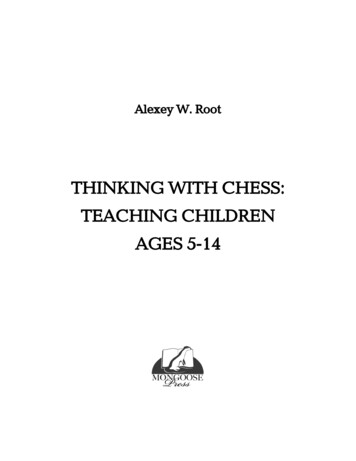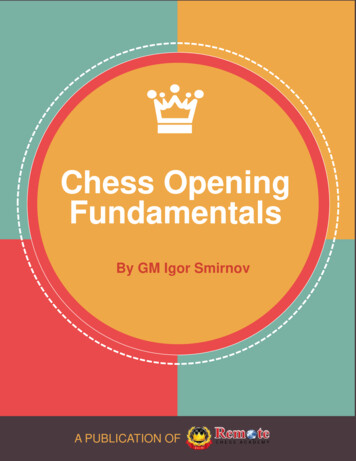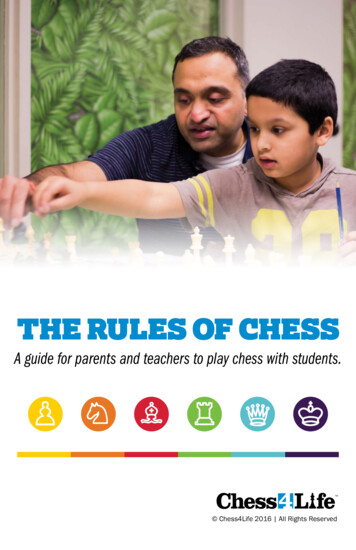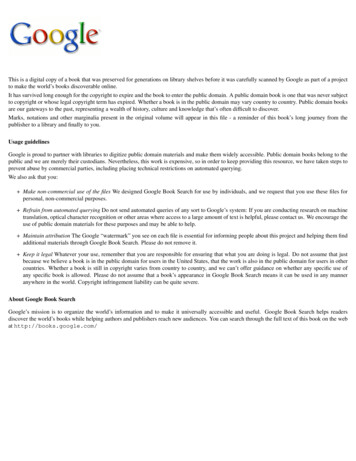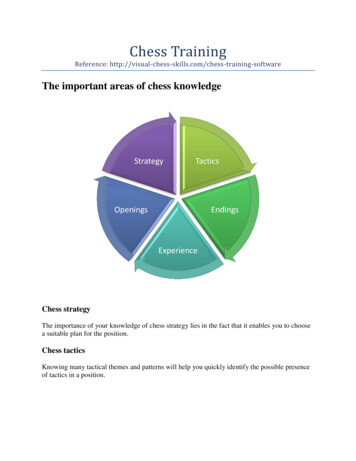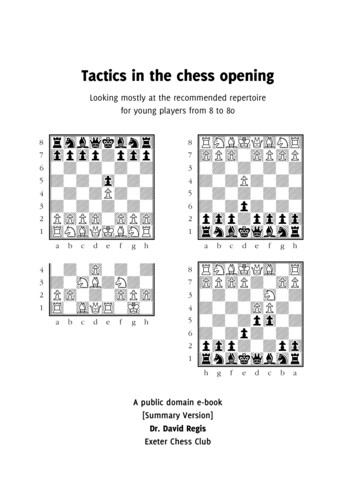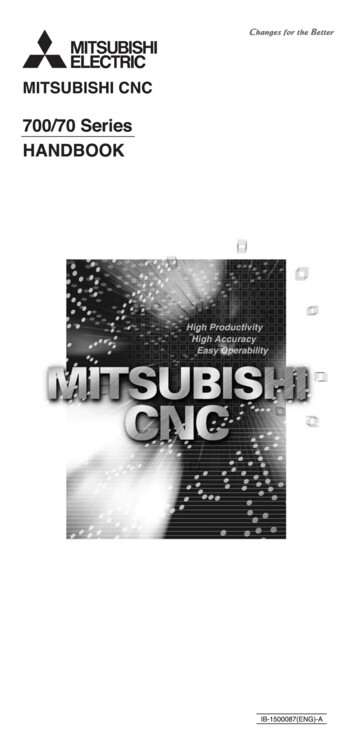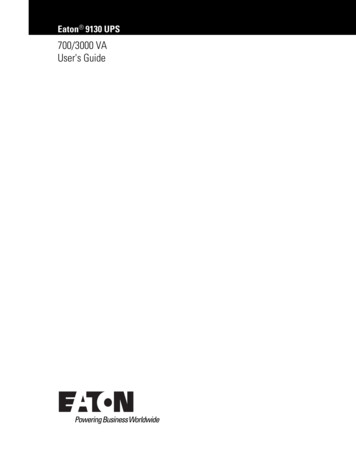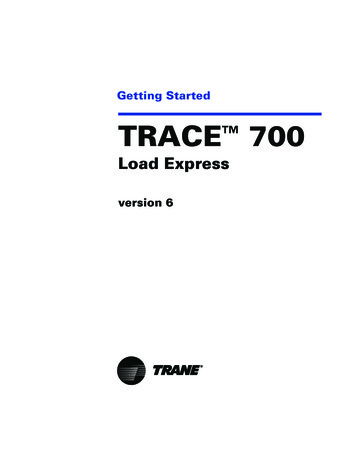
Transcription
700 CHESS PROBLEMSSELECTED FROM THE COMPOSITIONS OFMrs. W. J. BAIRD[1902]An Electronic EditionAnders Thulin, Malmö · 2002-11-18
PREFACEThe Chess Problems contained in this volume are the product ofthe labour and recreation of some fourteen years. I say “labour,”because I am not such a Chess enthusiast as to believe that a collection such as this can be produced without persistent application partaking of the nature of work; and “recreation,” becausethe work has been a pleasure—how great a pleasure only a composer can fully realize. Although a large number of the problemshave been republished in numerous papers at home and abroad,only the name of the publication in which each originally appeared is given. Exclusive of the prize list, in about a dozen caseswith a view to an improvement, they have been more or less resetsince their first appearance. The six added to this collection in letterpress at the end of the Solutions are the last composed.To the best of my belief there is not a single instance of a dualcontinuation, and not being an admirer of dual mates, they arevery few and far between.A list of prize problems will be found, but it must not be takenfor granted that it contains the essence of the volume.Solutions are given in full for the benefit of those who are not faradvanced in the Problem Art. As will be seen, red represents theWhite, and blue the Black pieces.Brighton1st May, 19025
CONTENTSList of Prize ProblemsDirect-Mate Problems:Two MovesThree MovesFour MovesFive MovesSelf-Mate Problems:Two MovesThree MovesFour MovesFive MovesSix MovesSolutionsNotes to Problemsp. 9problem 87688–694695–698699–700p. 211p. 277
PREFACE TO THE ELECTRONIC EDITIONThe original edition was published by Henry Sotheran & Co, London, 1902. As the original preface indicates, it was printed in redand blue.In this edition, solutions have been converted from descriptivenotation to algebraic, using the letter ‘S’ to indicate knights. Thedistinction between plain, double and discovered mates presentin the original has not been retained, except as far as lines thatwere considered separate because of this distinction have alsobeen kept separate in this edition. One example of this is the firstand third line in the solution to problem 24.Variations omitted from the original solutions, indicated by‘&c.’, have been added, in brackets.An extra section, containing publishing information (with occasional corrections of problem source), and notes about the problems taken from Mrs. Baird’s notebooks has been added after thesolutions.The dates given in the original proved to be the date of theaward given. The present edition tries to make this clearer byprinting them together with the award, rather than with thesource, as in the original.In the original several unnumbered problems were given in letterpress: these problems have been set in diagrams, and, if associated with another numbered problem, given the same numberfollowed by A, B, C, etc. in brackets. The six diagrams appearing7
8baird: 700 chess problemslast in the two-mover section were originally printed at the end ofthe solutions section.All problems have been computer tested, using MatthieuLeschemelle’s Problemiste v. 1.90, except for the last two problemswhich were checked with Popeye. Only four unsound problemswere found: 307, 627, 643 and 697.In those very few cases where computer testing showed thepresence of moves or variations not completely covered in theoriginal, these have been added to the solution in brackets, and setin italics.Occasional errors in mating moves have been silently corrected.AcknowledgementsI am very grateful to C. P. Ravilious, who generously made hisnotes on the original publishing dates as well as the history ofsome of the problems, taken from Mrs. Baird’s own notebooks,available for this edition.I also wish to thank the Library of the British Chess Problem Society for preserving Mrs. Baird’s notebooks and for making themavailable for research and publication.A. Thulin
PRIZE PROBLEMS, ETC.In the following List, all were “Open Competitions” with the exception of the Southern Counties’ Chess Journal and Sussex ChessJournal, which were limited to Sussex only.Two Moves1st Prize (Self-mate), Southern Counties’ Chess Journal2nd Prize, Sussex Chess Journal2nd Prize, West Sussex Times and Standard2nd Prize, Shoreditch Citizen2nd Prize, Wallasey and Wirral Chronicle2nd Prize (Tie), Southern Counties’ Chess Journal2nd Prize Manchester Weekly Times(also 3rd for “Best Set” with No. 331)2nd Tie, Morning Post2nd Tie, with No. 545, 1st Prize in Leisure Hour(Ladies’ Competition)2nd Prize (Self-mate), Hackney Mercury3rd Prize, Sheffield Weekly Independent3rd Prize, Brighton Society (Informal Competition)3rd Prize, Southern Counties’ Chess JournalHon. Men., Sheffield Weekly IndependentHon. Men., East Central TimesHon. Men., Hackney MercuryHon. Men., “Hackney Mercury Tourney,”conducted in British Chess MagazineHon. Men. (Self-mate), Brighton SocietyProblem in letterpress under Problem No. 5666a
10baird: 700 chess problemsThree Moves1st Prize, Manchester Weekly Times1st Prize, Hackney Mercury1st Prize, Southern Counties’ Chess Journal1st Prize, Cricket and Football Field (Half-yearlyCompetition)1st Prize, Southern Counties’ Chess Journal1st Prize, Sussex Chess Journal1st Prize, British Chess Magazine (Monthly Competition)1st Prize, Leisure Hour (Ladies’ Competition)1st Prize, Sussex Chess Journal1st Prize, Kentish Mercury1st Prize, Cricket and Football Field (Half-yearlyCompetition)2nd Best, Leeds Mercury Weekly Supplement2nd Prize (Special), Cricket and Football Field (Half-yearly Competition)3rd Prize, East Central Times3rd Prize, Sheffield Weekly Independent3rd Prize, Southern Counties’ Chess JournalHon. Men., Manchester Weekly Times (also 3rd for “BestSet” with No. 179)Hon. Men., Bristol MercuryHon. Men., Hackney MercuryHon. Men., Bristol MercuryHon. Men., “Hackney Mercury Tourney,” conducted inBritish Chess MagazineHon. Men., Bristol Times and Mirror, 1902 (Since theselection of the Problems for this 16583331407418480588597Two Mover.–2nd Prize, in “Reading Observer Topsy Turvey Competition,” 1902. Conditions: To produce the best and nearest likeness to an original problem with only the full solution for guidance.Full Solution.–Key: 1. Rc7, K Pc5, 2. Be3 ‡; 1. ., K Pe5, 2. Bg7 ‡;. 1. ., S P, 2. Se2 ‡; 1. ., Sd8/e7/b4/a5/a7/b8, 2. Sf3 ‡.
prize problems, lllVOriginal llllllllV2nd PrizeMost “Successful”* Problems fordifficulty in the Morning PostTwo Mover, for half-year ending June 30th, 1888Three Mover (2nd) for half-year ending June 30th, 1900Three Mover from the time the records werecommenced in 1887 to 1896Three Mover for half-year ending July 4th, 1891, and 2ndfor the whole year (republished from Bristol Mercury)Three Mover (tie) for half-year ending July 6th, 1889Four Mover for half-year ending July 5th, 189026337342407565607No. 149 was the first problem to appear in the columns of theTimes Weekly Edition, and in the half-year’s account proved themost successful in the Two-Move series.—«·»—The fascination of composing has always been far greater to methan that of solving. However, I have now and then entered a solution tourney, with the result that I have been successful in winning a few prizes. Over the board play has its charm, but only twice* The term “successful” indicates that the problems had the fewest numberof solvers, and were therefore considered the most difficult.
12baird: 700 chess problemshave I engaged in serious competition. In 1897, I entered for theLadies’ Championship for Sussex, which I won without the loss ofa game; and in 1900, in the Ladies’ section of Leisure Hour, I tiedfor first prize.
TWO-MOVE PROBLEMS
two-move vllllllllVIllustrated Sporting llllllVMorningDramatic NewsFirst attempt at a chess WDK}vllllllllVEnglish Mechanic andWorld of llllllllVVanity Fair
16baird: 700 chess vllllllllVIllustrated London News6.cuuuuuuuuC{WIWDNDBD}{DW0WDpDr}{wDPDWDnD}{ lllllllVSheffield Weekly Independent3rd Prize, kdb lVBritish Chess {hNDk0N0p}{W0WDWDr }{DWDpDW0W}{WDWDWDWD}{DWDWdWGW}vllllllllVArt and Literature
two-move W}vllllllllVPen and llllllllVChess vllllllllVGlasgow Weekly llllllllVLeeds Mercury Weekly Supplement
18baird: 700 chess }vllllllllVNottinghamshire }vllllllllVShoreditch vllllllllVNorwich }vllllllllVIllustrated Sporting andDramatic News
two-move wD}{dwdkdwIW}{WDWdW)WD}{dRDBhwDw}{WDW)WDWd}{DWDW WDW}vllllllllVEvening News and DWDW}vllllllllVWeekly Gazette DW}vllllllllVKentish Express and Ashford News
20baird: 700 chess }{dpdkdN0R}{WDWdWDW0}{DW)NdwDP}{W)W WDWD}{!WDWDWDW}vllllllllVPictorial lllllllVHereford lllllllVCricket and Football lllllllVWit and Wisdom
two-move DW}vllllllllVIllustrated London llllllVMorning Post27.cuuuuuuuuC{wDWDNDWD}{!WDp DWD}{DW WDWDW}vllllllllVManchester Weekly lllllllVVanity Fair
22baird: 700 chess }{dW)wiw)w}{WDPHpDWD}{DKDwDW)W}{WDWDWDwD}{DWDW WDW}vllllllllVIllustrated Sporting lllllVLeeds Mercury Weekly SupplementDramatic News31.cuuuuuuuuC{wDWDW C{wDW DwDP}{QDKDNDwD}{DWDRDWGW}vllllllllVWestern Magazine and Portfolio
two-move DW}vllllllllVBradford Observer llllllllVEast Central }vllllllllVEast Central lllllllVNottingham Guardian
24baird: 700 chess }vllllllllVSurrey vllllllllVBritish Chess Magazine38.cuuuuuuuuC{WhWgkDN }{WDWDWdWD}{DWDRdWDw}vllllllllVRossendale Free lllllllVHereford Times
two-move }{ whwdWdB}{WDpDkDND}{DW)W)WDw}{wDW WDW)}{DNDWdWDw}vllllllllVSussex Chess d}{ BdkdW0W}{WDwDwDWD}{)W0WIWDw}{rHWDWDW!}{DWDW WGw}vllllllllVHackney Mercury2nd Prize, llllllVKentish vllllllllVIllustrated London News
26baird: 700 chess problems44.cuuuuuuuuC{WDWdWdWD}{DNDWIWdW}{W0WdwDWd
700 CHESS PROBLEMS SELECTED FROM THE COMPOSITIONS OF Mrs. W. J. BAIRD [1902] An Electronic Edition Anders Thulin, Malmö · 2002-11-18. 5 PREFACE The Chess Problems contained in this volume are the product of the labour and recreation of some fourteen years. I say “labour,” because I am not such a Chess enthusiast as to believe that a col-lection such as this can be
